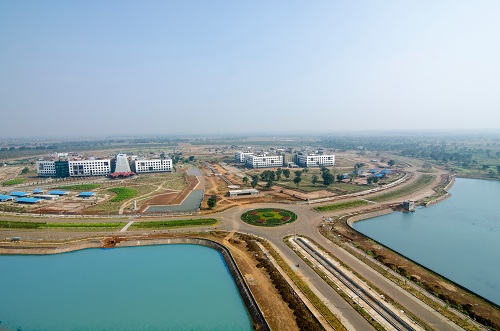Naya Raipur (officially known as Atal nagar) is the first Greenfield city in the country and one of world’s first integrated cities. The city is located between NH-6 and NH-3 at a distance of 17 km from the old Raipur, the capital and largest city of Chhattisgarh with Swami Vivekananda Airport separating old and new Raipur. The state of Chhattisgarh came into existence on November 2000 by carving out the southern part of Madhya Pradesh. Naya Raipur or Atal Nagar is the sixth planned city in the country after Jamshedpur, Bhubaneswar, Gandhinagar, Chandigarh, and navi Mumbai, and fourth planned capital city in the country.
The city takes care of every walk of individual and societal lives as 27 percent of the city is reserved for recreational activities and green areas, 23 percent for government offices and educational institutions while 30 percent of the city will be used for residential and commercial purposes. The Naya Raipur Development Authority (NRDA) acquired 41 villages to build a city with state of art infrastructure, cutting edge technology and robust public amenities system. Naya Raipur sets an example as far as developing new cities in the country is concerned. In the process of establishing Amravati, the city being built as capital of newly separated state of Andhra Pradesh; lessons can be learnt from Atal Nagar. Jharkhand also plans to build a new city on the lines of Naya Raipur.
Naya Raipur symbolises the economic growth of Chhattisgarh in last one and a half decade under the leadership of Dr. Raman Singh. From being one of the poorest regions of country, prone to security threats, the state has become the industrial hub of central India. The state is gifted with natural resources but these resources were never used efficiently in the benefit of the state. In the last one and a half decade, the state has become a power hub and emerged as a key destination for important industries like steel. The development of industries gave the state a much required boost, as tax payers’ money was spent on the welfare of poor and tribal population of the state.
“When we came to power in 2003, the state was facing several problems, including Naxalism, but now the situation has changed. In 2003, the budget of the state was Rs 7,000 crore which has now expanded to a whopping Rs 78,000 crore. Power generation capacity as well as telecommunication facilities have increased in the state,” said Raman Singh in an interview in 2016. “Chhattisgarh was once termed as a backward state but now it is attracting maximum industrial investment across the country,” he added.
The state of Chhattisgarh accumulated most of the financial resources to develop the world class city on its own rather than asking for aid from central government like Andhra Pradesh. “More than Rs 10,000 crore — Rs 5,000 crore for building physical infrastructure, rest on land acquisition — has been invested so far. Major chunk is from state resources,” said Aman Kumar Singh, chairman, NRDA.
Atal Nagar is definitely an achievement for Raman Singh’s government in Chhattisgarh which has been able to defeat the anti-incumbency in the last two elections. The success story of Atal Nagar also symbolizes the growing appetite of Indians to live in urban areas equipped with cutting edge technology and state of the art infrastructure.
